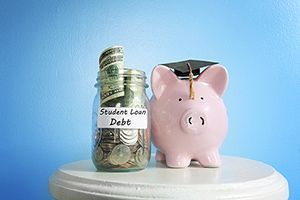Whether you accept it, avoid it or live somewhere in between, insurance coverage has become a defining issue for our profession. Patients increasingly expect to use their benefits, practitioners want to be compensated fairly for their time and expertise, and the system itself remains – at best – fragmented. The encouraging news is that coverage has expanded in meaningful ways. The challenging news is that reimbursement, across the board, remains inadequate.
Mastering Your Federal Student Loans
If you have federal student loans, then you know - along with 47 million other borrowers holding nearly $1.7 trillion in debt - that they can be one of the most costly, complicated and time-consuming factors affecting your financial well-being. But it doesn't have to be that way. Let's explore the best options for effectively managing your debt, saving you time and potentially lots of money, while setting you up for financial sovereignty.
Loan Repayment Options: Balance-Based vs. Income-Driven
To begin it's important to know the difference between balanced-based and income-driven repayment (IDR) options. Balanced-based plans act much like a standard loan; the goal is to pay it off as quickly as possible with the lowest interest rate available.

If you are a high-earner (>$100,000) or nearing the end of your loan, you may want to continue in your existing balanced-based plan, especially if you have a low rate (<6 percent) or have the option to refinance. However, for many professionals, the cost of their education is simply too high for their income-earning potential and paying off the loans is nearly impossible.
This reality, that borrowers will never be able to pay off their loans, is why the government created IDR plans. IDR is determined based on your family's income and balances are "forgiven" at the end of the 20-25 years. The "forgiven" balance is treated and taxed like earnings, so depending on your tax bracket for that year, it could result in significant savings.
Income-Driven Repayment: Why It's a Better Choice
Let's say you have $100,000 outstanding due on the principal loan with a 6 percent interest rate and $0 payments for the 25-year life of the loan:
- You would accrue $150k in interest, which added to the original principal, results in a total tax implication of $250,000 (calculate at www.finaid.org)
- At the highest tax bracket of 37 percent, you would owe $92,500 in federal income taxes, which is $7,500 less than your original loan of $100,000.
- Loan forgiveness after the 25-year loan term would save you $157,500.
- For those eligible, the REPAYE program goes a step further and subsidizes 50 percent of the accrued interest every year. Thus, at the end of the term, the $150k in interest is cut in half, resulting in additional savings of $27,550 per our example.
Overcoming the Financial Pitfall of "Capitalized Interest"
These IDR programs have helped many borrowers avoid defaults due to inability to pay and the resulting "capitalized interest," which can spiral their debt out of control. Capitalized interest is the accrued interest that becomes part of the principal balance. For example, $100k at 6 percent interest over five years will accrue $30,000 in interest. When loans are consolidated, as well as when in deferment and forbearance, that interest will be added to your principal and going forward, interest will be charged on this new balance of $130k.
This is where many borrowers are forced into extremely difficult financial situations that may affect their ability to stay in business or buy a home; and at the extreme, lead to wage garnishment and bankruptcy. This can all be avoided if only the borrower had the right guidance and proper management from their loan servicers.
Instead, our team of professional processors reports upwards of a 30 percent error rate on new enrollment and annual certifications; and that without properly filing and diligently following through, these mistakes can get you kicked out of your plan and automatically capitalize your accrued interest.
These challenges are why so many borrowers are paying too much for their education and despite all their efforts falling deeper into debt.
Invest in Your Future
The goal is simple: With balanced-based plans, you want to pay them off as quickly as possible to reduce the overall cost of the loan. With IDR plans, your aim is to pay as little as possible over the life of the loan to ultimately get the most amount of debt forgiven and use this extra cash flow to plan for the future.
So, rather than burn your money on interest payments that don't even touch the principal, you can instead invest that money for the future tax implication ... and then some.
Consider a $500 monthly contribution with a 4 percent annual return on investment over the 25 years of your loan. In 25 years, you would have accrued $251,208.37! That's $100,000 in interest income, and you now have $250k total to cover taxes on the forgiven amount of your loan ... and keep the rest for college funds and retirement plans.
Is It Time to Rethink Your Student Loan Strategy?
I encourage high earners who are already several years into repayment plans to pay off their loans as quickly as possible with higher interest debts (credit cards, etc.), paid off first, refinanced or settled. Resolving early reduces the overall cost of the loan by cutting off the accumulation of interest.
Many others would benefit from IDR programs because of lower earning potential and will need to take advantage of loan forgiveness, while investing for the tax implication, 20-25 years down the line.
There is no shame in not paying back your loans in full! The schools and teachers have already been paid and the federal government created these programs because we need highly skilled service professionals, like you, in all sectors of the economy. The real concern is how these complexities and inefficiencies have negatively affected the very people student loans were intended to serve.



